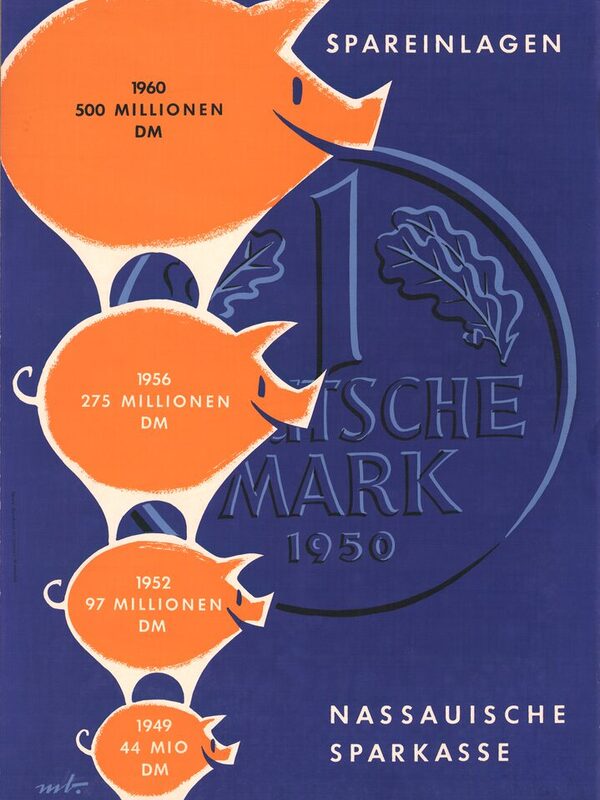Nassauische Sparkasse (NASPA)
The Nassauische Sparkasse was founded by edict on January 22, 1840 under the name "Herzoglich Nass. Landeskreditkasse" as a state bank. The aim was to create favorable credit opportunities for the inhabitants of the state, in particular for the redemption of tithes. Refinancing was carried out via interest-bearing promissory bills and savings deposits, via deposits and via non-interest-bearing papers, so-called Landeskreditkassenscheine, which were put into circulation as banknotes. Unlike the promissory bills, the savings deposits, which could be terminated at short notice, were tied to fixed upper limits and were primarily intended to appeal to the poorer population. The state tax authorities were liable for all liabilities of the financial institution; all profits were the property of the state. The entire organization was also in the hands of the state. A separate directorate was set up to manage the bank. The local branch offices were located in each of the 28 administrative districts, so that a comprehensive branch network was in place from the outset. During the revolution of 1848/49, the Landeskreditkasse was renamed Landesbank by law on February 16, 1849 and its scope of business was expanded. This included granting more credit to tradesmen, discounting bills of exchange and - to boost savings activity - higher interest rates for savings deposits.
After the annexation of Nassau, the Landesbank was divided into two financial institutions: a Nassauische Landesbank and a Nassauische Sparkasse. The former was to focus exclusively on the real estate lending business. Important business areas such as maintaining a current account, accepting giro and commission orders, operating on the money market and dealing with other banks remained the preserve of the Prussian state bank. It was not until the Landesbank Act of April 16, 1902 that many of these restrictions were lifted. In 1911, Nassauische Landesbank also assumed the function of a giro center for the public savings banks in the Wiesbaden administrative district. A life insurance company was added in 1913, a war insurance company to provide for the surviving dependents of fallen soldiers in 1914 and a building society in 1929.
The sister institution Nassauische Sparkasse concentrated primarily on the savings bank business. Innovations from the mid-1880s included the authorization of higher savings amounts up to an upper limit of 30,000 marks as well as the introduction of savings books and the establishment of special school savings banks. The savings deposits were used profitably for interest-bearing loans, which inevitably led to overlaps with the activities of the Landesbank. Organizationally, the two institutions were closely linked. They had a joint management, a joint head office in the building on Rheinstrasse, which was occupied in 1863 and greatly extended in 1914-16, and in some cases also joint agencies in the state. From the mid-1880s, full-time bank officials were employed and the branch network was expanded in line with demand. In addition, voluntary "collection points" were set up, which were given the name "branch offices" in the 1920s, while the "agencies" were called "Landesbank offices" from the beginning of the century. Since 1869, the sponsor of the two successor institutions was the Kommunalständischer Verband des Regierungsbezirks Wiesbaden. It was liable for all liabilities, but also participated to a considerable extent in the profits.
Nassauische Landesbank and its associated Nassauische Sparkasse survived the Nazi era and the Second World War relatively unscathed, although there was no lack of verbal bowing to the Nazi regime. A difficult situation arose in 1945 with the division of the Wiesbaden administrative district into the American and French zones, as this also tore apart the business territory of the two financial institutions. Nevertheless, the common business basis was retained. However, an additional head office had to be temporarily set up at the Oberlahnstein regional bank. The two Nassau financial institutions spent over 83 years under the umbrella of the Wiesbaden District Association, which temporarily lost its democratic underpinning during the Nazi era and operated as a provincial association for a time. By law dated 07.05.1953, the state of Hesse dissolved the Kommunalständischer Verband as of 01.06.1953 and created a new organizational structure for its area of responsibility. Nassauische Landesbank was transferred to Hessische Landesbank Frankfurt, Nassauische Sparkasse remained an independent institution, but was given a new guarantor in the form of the State of Hesse.
Nassauische Sparkasse was remunicipalized in 1991. Ownership was transferred from the state of Hesse to the Nassau Savings Bank Association, which was formed by the cities of Frankfurt and Wiesbaden, the districts of Hochtaunus, Main-Taunus, Rheingau-Taunus and Limburg-Weilburg in Hesse and the districts of Rhein-Lahn and Westerwald in Rhineland-Palatinate. With the exception of the Weilburg part of the Limburg district, their administrative districts also form the current business area of Nassauische Sparkasse. It covers around 4,200 km² with two million inhabitants, making it the second largest of all 438 German savings banks.
Literature
Lerner, Franz: Economic and social history of the Nassau region 1816-1964, Wiesbaden 1965.
